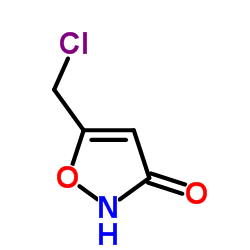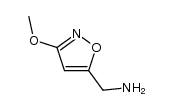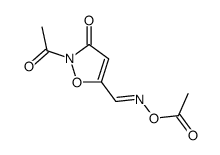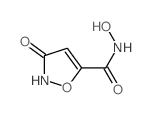2763-96-4
| Name | muscimol |
|---|---|
| Synonyms |
5-(aminomethyl)-1,2-oxazol-3-one
5-Aminomethyl-3-hydroxy-isoxazol PANTHERINE 5-(Aminomethyl)isoxazol-3(2H)-one Agarine 5-Aminomethyl-3-hydroxyisoxazole UNII:D5M179TY2E 3(2H)-Isoxazolone, 5-(aminomethyl)- 3-Hydroxy-5-aminomethylisoxazole MFCD00057894 5-aminomethyl-isoxazol-3-one Agarin EINECS 220-430-4 5-(Aminomethyl)-1,2-oxazol-3(2H)-one Pantherin 3-Hydroxy-5-aminomethyl-isoxazole 5-Aminomethyl-3-hydroxy-isoxazole 5-Aminomethyl-3-isoxazolol |
| Description | Muscimol (Agarin), a psychoactive isoxazole, is a selective neurotransmitter GABA agonist. Muscimol Binds GABAA on both high- and low-affinity sites (Kd=10 and 270 nM, respectively), stimulating chloride efflux with an EC50 value of 200 nM. Muscimol passes the blood-brain barrier (BBB) and has memory-disrupting effects[1]. |
|---|---|
| Related Catalog | |
| References |
| Density | 1.4±0.1 g/cm3 |
|---|---|
| Boiling Point | 325.0±27.0 °C at 760 mmHg |
| Melting Point | 175-176ºC |
| Molecular Formula | C4H6N2O2 |
| Molecular Weight | 114.103 |
| Flash Point | 150.4±23.7 °C |
| Exact Mass | 114.042931 |
| PSA | 72.28000 |
| LogP | -0.93 |
| Vapour Pressure | 0.0±0.7 mmHg at 25°C |
| Index of Refraction | 1.556 |
Synonym:5-(Aminomethyl)-3-Isoxazolol; 5-Aminomethyl-3-Hydroxyisoxazole Section 2 - COMPOSITION, INFORMATION ON INGREDIENTS
Risk Phrases: 23/24/25 Section 3 - HAZARDS IDENTIFICATION EMERGENCY OVERVIEW
Toxic by inhalation, in contact with skin and if swallowed.The toxicological properties of this material have not been fully investigated.Highly toxic. Potential Health Effects Eye: May cause eye irritation. Skin: May cause skin irritation. Ingestion: May be fatal if swallowed. May cause irritation of the digestive tract. The toxicological properties of this substance have not been fully investigated. Inhalation: May cause respiratory tract irritation. The toxicological properties of this substance have not been fully investigated. Chronic: No information found. Section 4 - FIRST AID MEASURES Eyes: Flush eyes with plenty of water for at least 15 minutes, occasionally lifting the upper and lower eyelids. Get medical aid. Skin: Get medical aid. Flush skin with plenty of water for at least 15 minutes while removing contaminated clothing and shoes. Wash clothing before reuse. Ingestion: Never give anything by mouth to an unconscious person. Get medical aid immediately. Do NOT induce vomiting. If conscious and alert, rinse mouth and drink 2-4 cupfuls of milk or water. Inhalation: Remove from exposure and move to fresh air immediately. If not breathing, give artificial respiration. If breathing is difficult, give oxygen. Get medical aid. Notes to Physician: Section 5 - FIRE FIGHTING MEASURES General Information: As in any fire, wear a self-contained breathing apparatus in pressure-demand, MSHA/NIOSH (approved or equivalent), and full protective gear. During a fire, irritating and highly toxic gases may be generated by thermal decomposition or combustion. Runoff from fire control or dilution water may cause pollution. Extinguishing Media: Use agent most appropriate to extinguish fire. Use water spray, dry chemical, carbon dioxide, or appropriate foam. Section 6 - ACCIDENTAL RELEASE MEASURES General Information: Use proper personal protective equipment as indicated in Section 8. Spills/Leaks: Vacuum or sweep up material and place into a suitable disposal container. Clean up spills immediately, observing precautions in the Protective Equipment section. Avoid generating dusty conditions. Provide ventilation. Section 7 - HANDLING and STORAGE Handling: Wash thoroughly after handling. Remove contaminated clothing and wash before reuse. Use with adequate ventilation. Minimize dust generation and accumulation. Avoid contact with eyes, skin, and clothing. Keep container tightly closed. Avoid ingestion and inhalation. Storage: Keep container closed when not in use. Store in a tightly closed container. Store in a cool, dry, well-ventilated area away from incompatible substances. Section 8 - EXPOSURE CONTROLS, PERSONAL PROTECTION Engineering Controls: Facilities storing or utilizing this material should be equipped with an eyewash facility and a safety shower. Use adequate ventilation to keep airborne concentrations low. Exposure Limits CAS# 2763-96-4: Personal Protective Equipment Eyes: Wear appropriate protective eyeglasses or chemical safety goggles as described by OSHA's eye and face protection regulations in 29 CFR 1910.133 or European Standard EN166. Skin: Wear appropriate protective gloves to prevent skin exposure. Clothing: Wear appropriate protective clothing to minimize contact with skin. Respirators: Follow the OSHA respirator regulations found in 29 CFR 1910.134 or European Standard EN 149. Use a NIOSH/MSHA or European Standard EN 149 approved respirator if exposure limits are exceeded or if irritation or other symptoms are experienced. Section 9 - PHYSICAL AND CHEMICAL PROPERTIES Physical State: Powder Color: white Odor: Not available. pH: Not available. Vapor Pressure: Not available. Viscosity: Not available. Boiling Point: Not available. Freezing/Melting Point: 150 deg C Autoignition Temperature: Not applicable. Flash Point: Not applicable. Explosion Limits, lower: Not available. Explosion Limits, upper: Not available. Decomposition Temperature: Solubility in water: Specific Gravity/Density: Molecular Formula: C4H6N2O2.xH2O Molecular Weight: 114.10 Section 10 - STABILITY AND REACTIVITY Chemical Stability: Stable under normal temperatures and pressures. Conditions to Avoid: Incompatible materials, dust generation, excess heat, strong oxidants. Incompatibilities with Other Materials: Acid chlorides, acid anhydrides, strong acids, strong oxidizing agents. Hazardous Decomposition Products: Nitrogen oxides, carbon monoxide, irritating and toxic fumes and gases, carbon dioxide, nitrogen. Hazardous Polymerization: Has not been reported Section 11 - TOXICOLOGICAL INFORMATION RTECS#: CAS# 2763-96-4: NY3325000 LD50/LC50: CAS# 2763-96-4: Oral, mouse: LD50 = 22 mg/kg; Oral, rat: LD50 = 45 mg/kg. Carcinogenicity: Muscimol - Not listed by ACGIH, IARC, or NTP. Other: See actual entry in RTECS for complete information. Section 12 - ECOLOGICAL INFORMATION Section 13 - DISPOSAL CONSIDERATIONS Dispose of in a manner consistent with federal, state, and local regulations. Section 14 - TRANSPORT INFORMATION IATA Not regulated as a hazardous material. IMO Not regulated as a hazardous material. RID/ADR Not regulated as a hazardous material. USA RQ: CAS# 2763-96-4: 1000 lb final RQ; 454 kg final RQ Section 15 - REGULATORY INFORMATION European/International Regulations European Labeling in Accordance with EC Directives Hazard Symbols: T Risk Phrases: R 23/24/25 Toxic by inhalation, in contact with skin and if swallowed. Safety Phrases: S 23 Do not inhale gas/fumes/vapour/spray. S 24/25 Avoid contact with skin and eyes. WGK (Water Danger/Protection) CAS# 2763-96-4: 3 Canada CAS# 2763-96-4 is listed on Canada's NDSL List. CAS# 2763-96-4 is not listed on Canada's Ingredient Disclosure List. US FEDERAL TSCA CAS# 2763-96-4 is listed on the TSCA inventory. SECTION 16 - ADDITIONAL INFORMATION N/A |
CHEMICAL IDENTIFICATION
HEALTH HAZARD DATAACUTE TOXICITY DATA
|
| Symbol |

GHS06 |
|---|---|
| Signal Word | Danger |
| Hazard Statements | H300 |
| Precautionary Statements | P264-P301 + P310 |
| Personal Protective Equipment | Eyeshields;Faceshields;Gloves;type P2 (EN 143) respirator cartridges |
| Hazard Codes | T: Toxic; |
| Risk Phrases | 25 |
| Safety Phrases | S22;S45;S36/S37/S39 |
| RIDADR | UN 1544 6.1/PG 2 |
| WGK Germany | 3 |
| RTECS | NY3345000 |
| Packaging Group | II |
| Hazard Class | 6.1(a) |
| HS Code | 2934999090 |
|
~65% 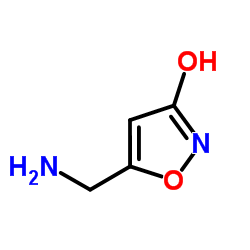
2763-96-4 |
| Literature: McCarry; Savard Tetrahedron Letters, 1981 , vol. 22, # 51 p. 5153 - 5156 |
|
~33% 
2763-96-4 |
| Literature: Konda; Takahashi; Onda Chemical and Pharmaceutical Bulletin, 1985 , vol. 33, # 3 p. 1083 - 1087 |
|
~60% 
2763-96-4 |
| Literature: Pevarello; Varasi Synthetic Communications, 1992 , vol. 22, # 13 p. 1939 - 1948 |
|
~38% 
2763-96-4 |
| Literature: Oster, Timothy A.; Harris, Thomas M. Journal of Organic Chemistry, 1983 , vol. 48, # 23 p. 4307 - 4311 |
|
~62% 
2763-96-4 |
| Literature: Chiarino, D.; Napoletano, M.; Sala, A. Tetrahedron Letters, 1986 , vol. 27, # 27 p. 3181 - 3182 |
|
~51% 
2763-96-4 |
| Literature: Jaeger; Frey 1982 , vol. No. 4, p. 817 - 820 |
|
~% 
2763-96-4 |
| Literature: Welch, W. M. Synthetic Communications, 1982 , vol. 12, # 14 p. 1089 - 1091 |
|
~% 
2763-96-4 |
| Literature: Nakamura, Norio; Tajima, Yawara; Sakai, Kiyoshi Heterocycles, 1982 , vol. 17, p. 235 - 245 |
| Precursor 7 | |
|---|---|
| DownStream 0 | |
| HS Code | 2934999090 |
|---|---|
| Summary | 2934999090. other heterocyclic compounds. VAT:17.0%. Tax rebate rate:13.0%. . MFN tariff:6.5%. General tariff:20.0% |
